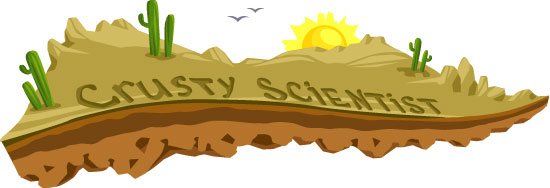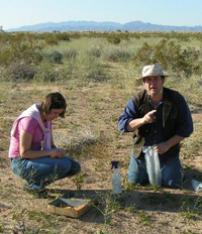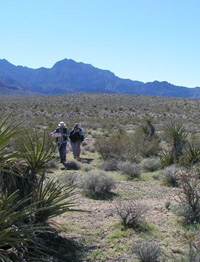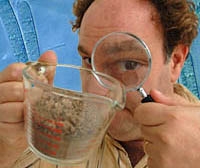
Illustrated by: Sabine Deviche
show/hide words to know
Professor Ferran Garcia-Pichel sweats the small stuff. The really, really small stuff to be exact. The easygoing Arizona State University-based microbiologist loves to look beyond the surface to explain what is happening in the tiny world of microbes.

Bacteria in soil crusts quickly turn the surface green once exposed to water.
"We're interested in studying the life and consequences of microbes in a natural environment. We essentially are environmental scientists that look beyond what most can see which are plants and animals," he said.
Tiny microbes with huge impact
The world of microbes is often overlooked by scientists, but their effects should not be underestimated, he said.
"We look at the immense populations of microbes that drive most environments' global cycling of the elements, but they're unseen (by others) because they're too small," he said.
But his research often goes beyond microbiology and biology. Through partnerships with colleagues near and far, Professor Garcia-Pichel's research allows his team to research subjects related to, but separate from biology like geology and chemistry.
"Essentially it's the search for advancement and knowledge. That's what really provides the drive and the kick for what we do," he said.

Professor Garcia-Pichel collecting samples with a student.
Recent experiments have studied the effects of microbes like cyanobacteria in ocean environments. His research also examines the characteristics of microbes in desert environments. Microbes can do incredible things like bore through rocks.
Some of what microbes do is still to be explained, but Professor Garcia Pichel's team continues work to uncover the science behind them.
Not just science
Another benefit to being a biologist is the opportunity to help students and researches on his teams. "I find it's a lot of fun to train people and to mentor people," he said. I enjoy that and I enjoy seeing people grow into the field."
Watching young researchers grow is just one rewarding aspect of his work. Each day, Professor Garcia-Pichel finds something new to love about his job.
"I can think of very few places where every day is completely different from the previous day," he said. "I don't think you can pay for that with money. Every day is an experience, every day is a challenge, every day there is something new."

A walk in the Sonoran Desert often becomes a CSI detective story.
The good, the bad, and the challenges
When asked what is his favorite part of being a biologist he is quick to say that it is working out in the field and doing experiments, which is only 15 to 20 percent of the time. "Most of the research is done in the lab," he adds.
His job, he said, is a mixed bag, but that's the way he likes it. With each day comes new and exciting problems to solve. "There are a lot of ups and downs, and there are a lot of challenges, but it's always fun," he said.
This section of Ask A Biologist was funded by NSF Grant Award number 020671.
View Citation

Microbiologist Ferran Garcia-Pichel studies the microscopic world just below the desert surface.
Be Part of
Ask A Biologist
By volunteering, or simply sending us feedback on the site. Scientists, teachers, writers, illustrators, and translators are all important to the program. If you are interested in helping with the website we have a Volunteers page to get the process started.







